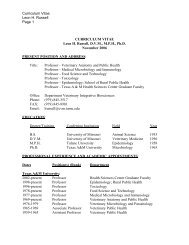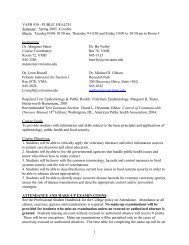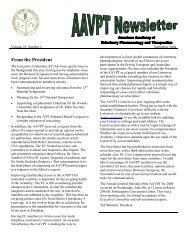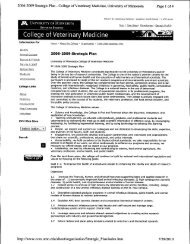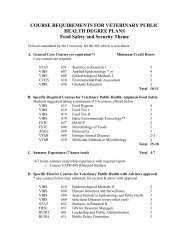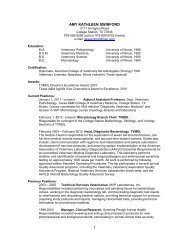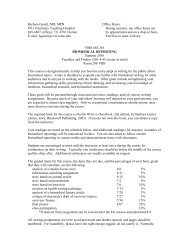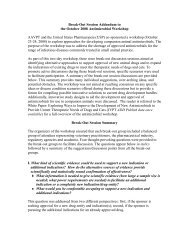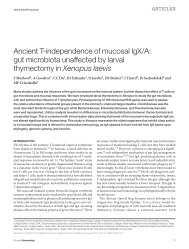Disaster - College of Veterinary Medicine - Texas A&M University
Disaster - College of Veterinary Medicine - Texas A&M University
Disaster - College of Veterinary Medicine - Texas A&M University
You also want an ePaper? Increase the reach of your titles
YUMPU automatically turns print PDFs into web optimized ePapers that Google loves.
Creating<br />
Researchers at <strong>Texas</strong> A&M <strong>University</strong>’s <strong>College</strong> <strong>of</strong> <strong>Veterinary</strong><br />
<strong>Medicine</strong> & Biomedical Sciences (CVM) have achieved another<br />
cloning first with the successful delivery <strong>of</strong> a foal using oocytes<br />
from a live mare, the first such clone in the world.<br />
The delivery <strong>of</strong> the foal highlights <strong>Texas</strong> A&M’s long tradition<br />
<strong>of</strong> leading science in equine reproduction and has been a great<br />
experience for the owner <strong>of</strong> the new foal.<br />
“I’ve always liked having three horses to ride,” said Kit Knotts,<br />
proud owner <strong>of</strong> Mouse, the foal that represents the successful<br />
cloning efforts and the latest in equine reproduction science at<br />
the CVM. “I called and emailed breeders to spread the word that<br />
I was looking. Everything I could turn up was either too small,<br />
too young, too old, not quite sound, etc. I realized I didn’t want<br />
just another horse to have another body in the barn, I wanted<br />
another Marc.”<br />
Knotts’ efforts to find a horse that had the same qualities as<br />
her prized Lipizzan stallion, Marc, (Pluto III Marcella) would<br />
lead her to <strong>Texas</strong> A&M <strong>University</strong> and equine reproduction<br />
expert, Dr. Katrin Hinrichs.<br />
“My local veterinarian, Dr. Brad Newman, mentioned that<br />
<strong>Texas</strong> A&M was cloning, but it was when Dr. Adam Eichelberger<br />
joined Newman Equine that we began to pursue the<br />
possibilities.”<br />
Dr. Hinrichs’ lab is noted for achieving the first cloned foal in<br />
North America, and the third in the world with Paris <strong>Texas</strong>, who<br />
arrived in 2005. The lab has since produced twelve cloned foals.<br />
Currently there are only three labs in the world that have reported<br />
the successful birth <strong>of</strong> cloned horses: <strong>Texas</strong> A&M <strong>University</strong>,<br />
Viagen (a commercial venture based in <strong>Texas</strong>), and the lab <strong>of</strong> Dr.<br />
Cesare Galli, in Italy.<br />
“We have worked on this clone for about two years,” said<br />
Hinrichs, a pr<strong>of</strong>essor in the Department <strong>of</strong> <strong>Veterinary</strong> Physiology<br />
& Pharmacology. “This is actually our first foal produced using<br />
oocytes, or egg cells, from live mares. We recovered the oocytes<br />
from our herd <strong>of</strong> research mares using the same method used to<br />
10 • CVM Today • Summer 2010<br />
opportunities for new knowledge,<br />
new therapies, & new learning<br />
<strong>Veterinary</strong> Researchers Achieve<br />
Cloning First<br />
by Angela Clendenin<br />
recover eggs from women for in vitro fertilization. We used the<br />
oocytes for the cloning process, which made it difficult as we had<br />
very few to work with at any one time. During the cloning process,<br />
we tested a new technique that has been reported in mice to<br />
decrease birthing problems. Mrs. Knotts has been very supportive<br />
<strong>of</strong> our efforts to clone her horse, and has even named the foal<br />
‘Mouse’ in honor <strong>of</strong> the research that produced him.”<br />
The process began with a biopsy <strong>of</strong> skin cells from Marc, the<br />
horse to be cloned. Through the cloning process using oocytes<br />
recovered from a live mare, viable embryos were developed and<br />
sent to Hartman Equine Reproduction Center, an embryo transfer<br />
facility in North <strong>Texas</strong> which works closely with Hinrichs’ lab,<br />
for transfer into surrogate mares. Minnie, the mare carrying<br />
Mouse, stayed in North <strong>Texas</strong> for approximately 200 days, then<br />
was sent to her new home in Florida.<br />
Minnie began to show signs <strong>of</strong> an early delivery, and was taken<br />
to the <strong>University</strong> <strong>of</strong> Florida <strong>College</strong> <strong>of</strong> <strong>Veterinary</strong> <strong>Medicine</strong> for<br />
observation and intervention. That’s where Mouse arrived and<br />
was cared for by a team <strong>of</strong> neonatal experts that helped make<br />
sure he would make it through this critical time.<br />
“Having Minnie with us for several months prior to foaling has<br />
been great,” added Knotts. “The teamwork between Dr. Hinrichs<br />
and her colleagues at the <strong>University</strong> <strong>of</strong> Florida has been outstanding,<br />
frankly saving Mouse’s life more than once before and<br />
after birth.<br />
Hinrichs noted that while Mouse is truly an identical twin to<br />
the original horse, Marc, that there will be differences as the foal<br />
grows due to environmental influences.<br />
“I have become really interested in the science involved,” notes<br />
Knotts. “Dr. Hinrichs has been wonderful about keeping me<br />
informed about what is going on in the lab and feeds my interest<br />
by explaining things in terms I can largely understand. I am very<br />
proud <strong>of</strong> the contributions our project has made to the body<br />
<strong>of</strong> knowledge about cloning, which benefits far more areas <strong>of</strong><br />
equine reproduction than most realize.”<br />
Photos <strong>of</strong> Mouse and Marc provided by Ben and Kit Knotts.




